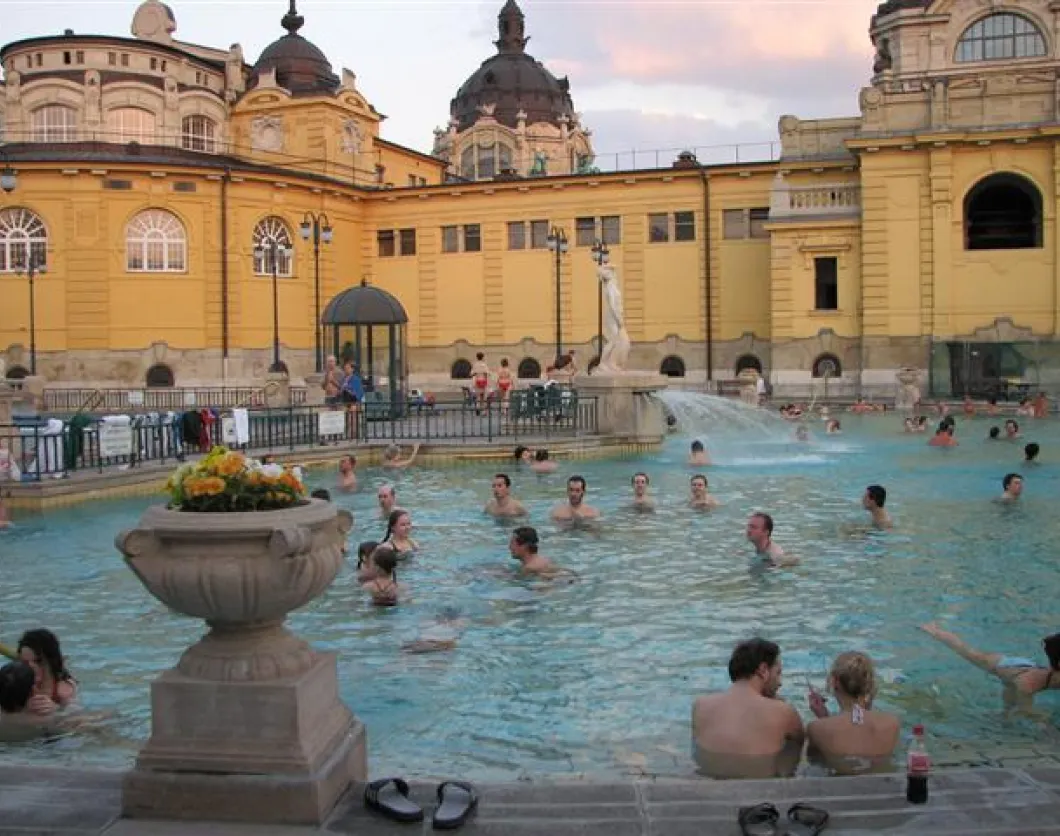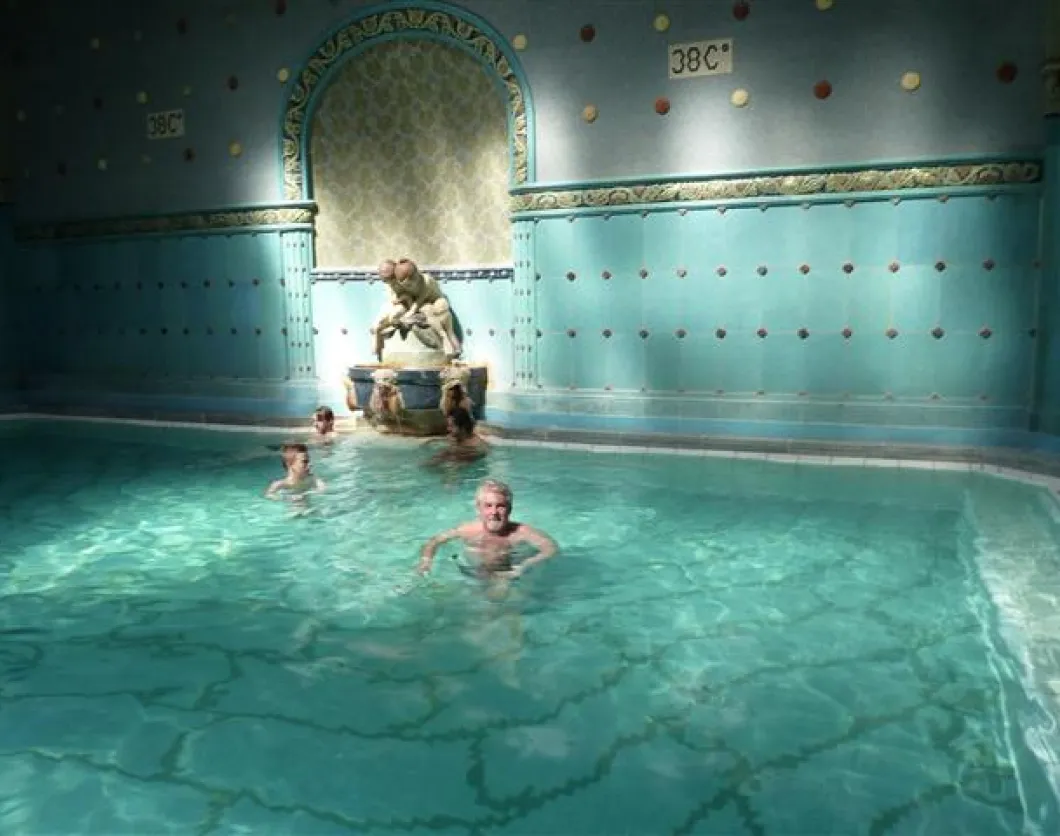“Push a birch rod firmly into the soil anywhere in Hungary and sooner or later some sort of thermal water, mineral water or spring will eventually gush forth.”
The above was said by a Hungarian chemist, Vilmos Hankó, in the 19th century. It might seem an exaggeration, but the fact is that there is thermal water under 70% of Hungary’s territory. Hungary is one of the five richest countries with thermal water in the world. There are more than 1300 thermal springs in Hungary, 200 of which have got proven curative power. Budapest, itself has got more than a hundred thermal springs.
In Hungary baths have been used for 2000 years for relaxing and healing. The Romans residing here in the first century were the first ones to use the local thermal baths. During the Turkish occupation in the 16th and 17th century thermal waters became popular again and several new public baths were erected. Some of these Turkish Baths are still operating and are open to the public.
In Hungary thermal baths offer not only wellness therapies, but medical treatments, too.
If you visit the country you shouldn’t miss out on visiting thermal baths. You can take a spa break at the unique thermal lake of Heviz or in one of the numerous bath complexes of Hungary.
Heviz Spa
The Heviz Spa is located on the shores of the Heviz Lake, which is the largest thermal lake in Europe. It’s a sight for sore eyes – the lake in the middle of the wooded park with the water-lilies which became its symbol. The water of the lake, with its particular chemical composition, and the mud covering the bottom of the lake are used for several treatments provided in the Heviz Thermal Spa.
Heviz Lake is Hungary’s first and most well-known thermal bath, which according to archaeological finds was also known to the Romans. The lake is fed by a natural hot spring so abundant, that the water of the Heviz Lake changes in every three days. The water has an average temperature of 33 ºC. As the temperature never falls bellow 24 ºC, it enables winter bathing. The constant water flow of the lake gives a natural massage effect. In addition, due to the condensation of the steam during the winter season, it creates a natural inhalatorium together with a spectacular view.
The Heviz Lake is surrounded by a wood, which has an important role in protecting its special microclimate from wind, dust and noise. The mineral-rich water and the curative mud of Heviz are applied for prevention and healing, as well.
Miskolctapolca Cave Bath
Miskolctapolca was already famous for its thermal water during Turkish times. A 150-meter-long cave was discovered in 1936. In this site the cave bath was built. The resort now offers health spa services and wellness treatments.
The thermal water (temperature: 30°C, 86°F) is reputed to cure pain in the joints, and since it has lower salt content than most thermal waters (around 1000 mg/litre), people can bathe in it for much longer, practically for an unlimited amount of time. The Cave Bath can be visited all year long except for January.
Sarvar Spa
Sarvar Spa is located at about 30 km from the Austrian border. The famous thermal crystal salt of Sarvar is used for locomotive, dermatologic and gynecologic diseases. The Wellness Centre offers several types of massages, beauty treatments and saunas. In addition children pools, slides and water games for the whole family are available.
Debrecen Spa
Debrecen Spa is located near the Hungarian-Romanian border. The thermal water of Debrecen Thermal Baths is used for 40 types of therapies. In the wellness centre you can choose from beauty treatments, massages, while the medical therapies of the health spa department are used successfully against locomotive disorders. The Debrecen Aquapark is very popular, too.
Gyula Castle Spa
Gyula is a little spa city in South-East Hungary. Gyula Castle Spa was built in the park of the Almasy Castle. You can relax in the Wellness and Sauna Centre, take health treatments in the health spa section while children will love the huge aqua playground.
Eger Bath
The only Turkish Bath in Hungary outside Budapest. It was built in the 16th century, during the Turkish Occupation. The ancient vault irreparably damaged over the last centuries was substituted. Beside the thermal pool with golden cupola other pools with water at different temperatures were built and there’s also a hamam (a type of steam bath). Near the Turkish Baths in Eger there are Thermal Baths and an outdoor spa, too.
Harkany Spa
Harkany is a spa city in South-Hungary with particular Mediterranean climate. In its indoor and outdoor pools several wellness and health spa treatments are available. The healing water of Harkany Spa is famous of its curative effect on rheumatism and psoriasis.
Zalakaros Spa
Zalakaros Spa is a bath complex near the Lake Balaton with thermal bath, adventure spa, outdoor spa and wellness centre. The Thermal Spa exists since 1965, its thermal water was discovered in the course of oil research. Since then it has become a spa complex offering wellness therapies and health treatments, too.
Hajduszoboszlo Spa
Hajduszoboszlo Thermal Spa is a huge bath complex with thermal bath, outdoor aquapark, indoor adventure spa and a swimming pool. The particular water of Hajduszoboszlo was discovered in 1925 in the course of oil exploration. The first bath was built 2 years later. The Hajduszoboszlo Aquapark was the first water amusement park in Hungary.
Bukfurdo
Hungary’s second largest bath complex is only 50 years old. The thermal water of Bukfurdo Spa Hungary was discovered in the 1950s in the course of oil exploration. Its first pool was built in 1962 and since then there have been constant developments and expansions on the premises. Today it houses 27 pools (thermal, swimming, children’s pools, adventure bath), a wellness centre and a slide complex in a pleasant wooded park.










